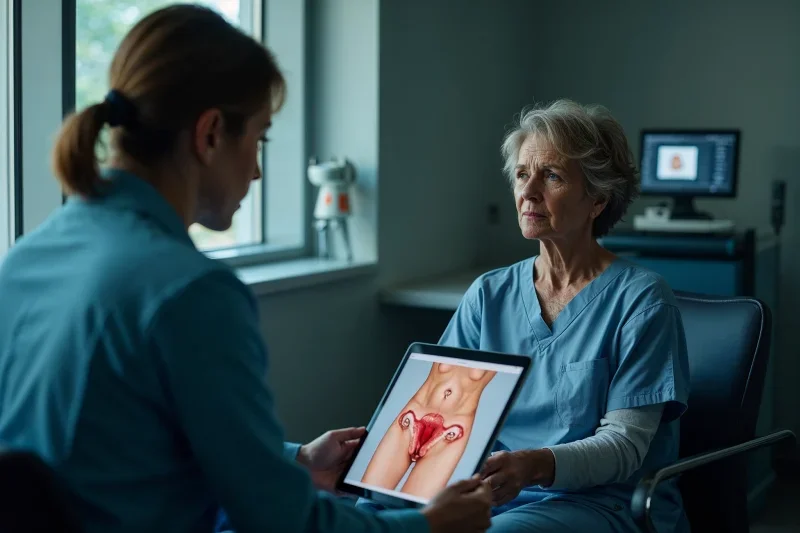Dispelling the Myths: Truths About Robotic Essure Removal and Reversal
Categories:
By: Ethan Cole
Robotic-assisted Essure removal and reversal surgeries provide enhanced precision, accuracy, and superior visualization compared to traditional methods.
Essure removal and reversal are two distinct procedures; removal deals with device extraction, while reversal also aims to restore fertility.
Robotic-assisted surgeries do not guarantee restored fertility post-reversal; success depends on numerous factors such as patient’s health and surgeon’s experience.
Robotic surgery has a proven safety record, reducing risks of device fragmentation, ensuring meticulous device removal, and minimizing patient discomfort.
Despite misconceptions, robotic surgeries are controlled by experienced surgeons and can lead to improved patient outcomes with less postoperative pain and shorter recovery time.
Introduction
We must address and dispel the misconceptions pertaining to robotic Essure removal and reversal. Contrary to certain suppositions, it is crucial to understand that robotic surgery is neither experimental nor fraught with risk. Instead, it is a technique that has been employed for many years to augment precision in Essure procedures. It is imperative to distinguish between removal and reversal - the former pertains to the extraction of the device, while the latter aims to reinstate fertility. It is noteworthy that robotic surgeries do not provide a guarantee of restoring pregnancy; the success rate varies and is contingent upon the patient’s health, age, and other influencing factors. Dispelling fear and apprehension, a detailed exploration into the subject can help elucidate these surgical procedures, thereby clarifying any misconceptions and highlighting their true potential.
Introduction to Robotic Essure Procedures
You may wonder, what is the Essure device and how did it come into existence? Well, we’re going to explore that, along with the emergence of robotic-assisted removal and reversal. It’s a fascinating and critical progression that’s reshaping the world of medical procedures.
Understanding the Essure Device and Its History
Developed in the early 2000s, the Essure device offers a less invasive alternative to traditional sterilization procedures. You may have encountered myths about Essure procedures, so here’s an opportunity to understand the Essure device and its history.
The Essure device is a small, flexible coil that’s inserted into the fallopian tubes through the vagina and cervix. Over time, tissue grows around the device, forming a barrier that prevents sperm from reaching the eggs. This design was revolutionary in its simplicity and non-invasive nature, but it wasn’t without risks.
One of the primary concerns was the risk of device fragmentation. In some cases, the Essure device could break apart, causing discomfort and complications. Yet, it’s important to remember that these instances were relatively rare and often due to improper insertion or individual body reactions.
Over the years, reports of complications led to scrutiny and, ultimately, the discontinuation of Essure in 2018. However, understanding the Essure device and its history can help dispel the myths surrounding it. By studying the past, we can better prepare for the future, ensuring safer and more effective sterilization procedures.
The Emergence of Robotic-Assisted Removal and Reversal
In recent years, the emergence of robotic-assisted removal and reversal has been a game-changer in handling Essure complications. This evolution in healthcare offers a sophisticated approach to robotic Essure removal that is both intriguing and enlightening. With robotic-assisted Essure surgery, you’re looking at a shift from conventional methods to an AI-driven technique.
The precision and accuracy of AI in robotic gynecological surgery are unparalleled. It’s a leap from traditional surgical interventions, offering less invasive procedures, reduced recovery time, and minimized risk of complications. You’ll appreciate that the robotic assistance gives surgeons a better view and superior control during the delicate process of Essure device removal.
On top of this, the robotic-assisted procedure also opens the door for Essure reversal. Previously, women implanted with the Essure device had little hope of fertility restoration. Now, robotic-assisted reversal offers a glimmer of hope.
In essence, the robotic revolution in Essure removal and reversal procedures offers a safer, more efficient, and potentially life-changing solution. It’s a breakthrough in managing Essure complications, demonstrating a promising future in gynecological healthcare.
Common Misconceptions About Essure Removal and Reversal
You might’ve heard that robotic surgery is experimental or unsafe, but that’s not the truth. Another common misconception is that Essure removal and reversal are the same procedure, which they’re not. And while it’s tempting to believe that robotic procedures guarantee pregnancy restoration, it’s important to know that this isn’t always the case.
Myth: Robotic Surgery is Experimental or Unsafe
Many people’s understanding of robotic surgery is shrouded in misconceptions, especially when it comes to Essure removal and reversal. You may have heard or read about the Essure surgical myths and facts, but it’s important to separate the wheat from the chaff.
Contrary to popular belief, robotic surgery is neither experimental nor unsafe. In fact, advanced robotic surgery for Essure has been around for years, providing a high degree of precision that’s hard to match with traditional surgical methods. The adaptability and precision of the robotic system enhances the surgeon’s capabilities, making complex procedures like Essure reversal more manageable.
But what are the benefits of robotic Essure reversal? For starters, the procedure is less invasive. Robotic technology allows for smaller incisions, reducing blood loss, and minimizing pain and recovery times. Furthermore, the 3D visualization provided by robotic technology enables surgeons to perform the procedure with a higher degree of exactness, which can result in better outcomes.
Myth: Removal and Reversal are the Same Procedure
Maneuvering through the world of Essure procedures can sometimes be confusing, primarily due to the misconception that Essure removal and reversal are the same. They’re not. Let’s break down the differences in essure removal vs. reversal to help you understand better.
Essure removal is a minimally invasive procedure focused on extracting the Essure device from your fallopian tubes. The goal here is to eliminate discomfort or adverse reactions you may be experiencing due to the device. However, removal doesn’t necessarily restore your fertility.
On the other hand, Essure reversal is a more complex procedure, aiming to restore your ability to conceive naturally. It involves not only removing the device but also repairing your fallopian tubes to enable egg transportation. This is where essure reversal success rates come into play. Although success can’t be guaranteed, many women have successfully conceived after the procedure.
You see, understanding the distinct objectives and outcomes of these procedures is key. It’s essential to discuss this with your healthcare provider and make the best decision for your health and future goals.
Myth: Robotic Procedures Guarantee Pregnancy Restoration
Exploring the domain of Essure procedures, you might come across the misconception that robotic procedures guarantee restored fertility. In dispelling Essure removal myths, it’s essential to clarify that, while precision robotic gynecological surgery has revolutionized the field, it doesn’t provide a 100% guarantee of pregnancy restoration.
Robotic surgery, with its improved visualization and precise movements, can indeed enhance the success rates of Essure removal and the subsequent tubouterine anastomosis procedures. These procedures, which reconnect the fallopian tubes, aim to restore a woman’s fertility. However, several factors influence the outcome, such as the woman’s age, overall health, and the extent of Essure device migration.
It’s also important to remember that pregnancy restoration doesn’t solely depend on successful Essure removal and tubouterine anastomosis. The male partner’s fertility health and the couple’s overall reproductive health play significant roles too. As a result, while the robotic procedure is a valuable tool in the journey towards fertility restoration, it’s not a guaranteed ticket to pregnancy. Always consult with your healthcare provider to understand the thorough landscape of Essure removal, reversal, and the journey back to fertility.
The Truth About Robotic-Assisted Essure Removal
You might be wondering how robotic assistance can improve Essure removal. Let’s explore how this technology enhances precision, minimizes the risk of fragmentation, and leverages simultaneous laparoscopy and hysteroscopy. By understanding these aspects, you’ll appreciate why robotic-assisted removal is a game changer in Essure procedures.
How Robotic Precision Improves Device Removal Accuracy
In the domain of medical advancements, robotic precision has become a game-changer for Essure removal procedures. With enhanced precision, robots can successfully navigate the intricate regions of the body, ensuring accurate device removal. This has a direct impact on your post-surgical recovery after Essure removal, leading to fewer complications and quicker recovery times.
Robotic precision brings an unprecedented level of control to the process, reducing the chance of human error during the operation. This results in less tissue damage and a more successful removal of the Essure device. The precision also allows for minimal invasion during the procedure, reducing your discomfort and speeding up recovery.
Moreover, robotic precision isn’t just about the physical removal of the device. It’s about the careful planning and execution of the procedure, tailored to your specific needs. A robot-assisted approach offers a more personalized and precise procedure, ensuring that you have a successful and straightforward post-surgical recovery.
Minimizing Risks of Fragmentation with Robotic Technology
Robotic-assisted technology serves as your safety net when it comes to minimizing the risks of fragmentation during Essure removal. The precision and control provided by this advanced tech greatly reduces the chance of device breakage, guaranteeing a cleaner, safer process.
Now, you might wonder, how does this work? Well, robotic technology allows for meticulous dissection and removal, reducing undue force that could potentially cause breakage. It’s like having a skilled surgeon with an unerring hand, amplified by the precision of a machine.
But it doesn’t end there. The high-resolution, 3D imaging provided by the robotic system guarantees the surgeon can clearly see every detail, every part of the device, minimizing the risk of leaving fragments behind. It’s an extra layer of safety, an additional assurance that the job isn’t just done, but done right.
In the end, the use of robotic-assisted technology isn’t just about precision — it’s about reducing risks and enhancing patient safety. It’s a tool that gives you, the patient, the best possible outcome when it comes to Essure removal. And in your journey towards health, isn’t that what matters most?
The Role of Simultaneous Laparoscopy and Hysteroscopy
Simultaneous laparoscopy and hysteroscopy play crucial roles during robotic-assisted Essure removal. These procedures give your surgeon a clear view of your pelvic organs and provide direct access for removal of the Essure device.
Laparoscopy involves a small camera inserted through a tiny incision in your abdomen, allowing the surgeon to visualize the Essure device and surrounding tissues. Hysteroscopy, on the other hand, uses a thin, lighted tube inserted into your vagina to examine the inside of your uterus. Together, they guarantee a thorough assessment, minimizing the risk of leaving any fragments behind.
However, it’s not just about the visuals. These procedures also allow your surgeon to perform delicate manipulations with precision. The robotic assistance enhances the surgeon’s control, even in the tight spaces of your pelvic area. This reduces the chance of injury or complications during the procedure.
Call now to schedule an appointment with Dr. Jason Neef and explore your fertility options.
Insights into Robotic Essure Reversal
Now, let’s turn your attention to the intricacies of Robotic Essure Reversal. You’ll explore the process of restoring tubal patency through tubouterine anastomosis, understand the factors that can influence the success rates in reversal procedures, and compare the robotic reversal to traditional techniques. Each of these aspects will provide a deeper understanding of the technique’s efficiency and effectiveness.
Restoring Tubal Patency: A Closer Look at Tubouterine Anastomosis
Diving deep into the world of robotic Essure removal, we find the innovative procedure of Tubouterine Anastomosis playing a significant role in restoring tubal patency. This technique, a representation of medical technology’s evolution, is a key player in the reversal process after Essure.
Let’s break it down for you. In simple terms, Tubouterine Anastomosis refers to the surgical connection of the fallopian tubes and the uterus. It’s a delicate process requiring precision and expertise. But, why is it so vital? It’s because this procedure provides a pathway for the egg to move from the ovary to the uterus, a necessary step for natural conception.
Robotic-assisted Tubouterine Anastomosis, a minimally invasive approach, takes this technique to a whole new level. It’s not just about reconnecting; it’s about restoring functionality. The procedure utilizes high-definition 3D vision and miniature instruments, enhancing the surgeon’s dexterity.
Factors That Influence Success Rates in Reversal Procedures
There are numerous factors that can greatly impact the success rates in reversal procedures like robotic Essure removal. One of the most critical factors is the surgeon’s skill level and experience. The more proficient your surgeon is with this type of procedure, the higher your chances of a successful outcome. It’s not just about the technical skills either. Your surgeon’s understanding of the nuances around your particular case, coupled with their ability to tailor the procedure to your specific needs, is also paramount.
Another key factor is your overall health status. Generally, healthier patients tend to have better outcomes. Conditions like obesity, diabetes, or any other chronic health conditions could potentially complicate the procedure and lower the success rate.
Lastly, the type and extent of damage to your fallopian tubes can also influence the success of the procedure. Less damage often means higher success rates. However, don’t be discouraged if you’ve been told your tubes are extensively damaged. Remember, every case is unique, and with the right surgeon, even the most complex cases can potentially achieve success.
Comparing Robotic Reversal to Traditional Techniques
Understanding the factors influencing the success rates of Essure removal procedures sets the stage for a deeper look into the actual techniques employed. You’ll soon realize that the methods used can greatly affect your recovery and overall success rate of the procedure.
Let’s dig into the comparison between robotic and traditional techniques. Robotic reversal is a minimally invasive procedure. Your surgeon uses a robot-enhanced device for precise removal, reducing the risk of damage to surrounding tissues. This technique often results in less pain, lower risk of infection, and quicker recovery times.
On the other hand, traditional techniques often require a larger incision, which can lead to increased pain, higher risk of infection, and longer recovery times. They also require a manual approach which, while effective, doesn’t offer the same level of precision as a robotic approach.
In short, while both techniques can successfully remove Essure, the robotic method tends to surpass traditional techniques regarding precision, safety, and recovery time. It’s clear that technology has notably improved the landscape of Essure removal, offering you a safer, more efficient option.
Advantages of Robotic-Assisted Essure Procedures
You might be wondering why one would choose robotic-assisted Essure procedures over traditional methods. The reasons are clear: smaller incisions mean less scarring and a quicker recovery, the risk of complications during surgery is diminished, and complex cases benefit from enhanced visualization and precision. Let’s break down each of these advantages to get a better understanding.
Smaller Incisions, Reduced Scarring, and Faster Recovery
Embrace the advantages of robotic-assisted Essure removal procedures, a game-changer in the medical field. With this cutting-edge technology, you’ll benefit from markedly smaller incisions. Traditional surgeries often require larger cuts, leading to more scarring and longer healing times. However, robotic-assisted procedures minimize these concerns, resulting in less visible scarring.
Furthermore, you’ll also experience a faster recovery. The precision of robotic assistance reduces unnecessary trauma to your body, promoting quicker healing. You’ll be back on your feet sooner, returning to your normal activities with minimal downtime. This is particularly beneficial if you’re a busy professional or have family responsibilities that demand your attention.
Lastly, the smaller incisions also play a critical role in minimizing postoperative pain. You’ll likely require fewer pain medications, making your recovery smoother and more comfortable. This isn’t just about comfort, either. Lower reliance on pain medication can reduce potential side effects and complications.
Lower Risk of Complications During Surgery
One major advantage of robotic-assisted Essure procedures is a notably lower risk of complications during surgery. This isn’t just a sales pitch, it’s a fact backed by numerous research studies. You see, the precise, robot-guided movements minimize the chance of human error, which reduces the likelihood of unexpected issues.
When you choose robotic-assisted Essure removal, you’re choosing a method that’s known for its safety. In fact, studies show that patients who undergo robotic procedures experience fewer complications compared to traditional surgery. These include less blood loss, lower rates of infection, and reduced pain after surgery. That’s because robotic systems offer unparalleled precision and control, enabling surgeons to perform complex tasks without causing unnecessary tissue damage.
You must understand that any surgical procedure carries some risks, but by opting for a robotic-assisted method, you’re greatly reducing these. It’s not just about comfort or convenience. It’s about making a smart choice for your health. So, when you’re considering Essure removal, remember the lower risk of complications that comes with robotic-assisted procedures. It’s one of the many reasons why it’s worthy of your consideration.
Enhanced Visualization and Precision in Complex Cases
Often, the complexity of Essure removal cases can pose considerable challenges. However, with the advent of robotic-assisted procedures, you’ll find that these challenges are greatly diminished. This technology provides an enhanced level of visualization, allowing surgeons to see the intricate details of your anatomy in high definition. This crystal-clear view helps them to navigate complex cases with greater precision.
Imagine a scenario where the Essure device has migrated or embedded in the tissue. The precision offered by robotic assistance becomes invaluable. It isn’t just about seeing better; it’s about performing delicate maneuvers with extraordinary accuracy. Your surgeon can carefully remove the device without causing unnecessary damage to surrounding tissues. That’s the kind of precision we’re talking about.
Robotic technology also provides a higher degree of control. Surgeons aren’t left to rely on their steadiness alone; the robotic system can filter out any potential tremors, ensuring that every movement is purposeful and precise. This increased control can lead to better outcomes and reduced risk of complications.
In complex cases, robotic-assisted Essure removals aren’t just an advantage; they’re a necessity. You deserve this level of precision and care.
Addressing Concerns and Challenges in Robotic Procedures
You might be wondering, “Can robotic techniques handle severe complications?” You’re not alone. It’s also essential to navigate patient anxiety and misunderstandings effectively, while managing expectations for post-surgical outcomes.
Can Robotic Techniques Handle Severe Complications?
Despite the cutting-edge advancements in robotic surgery, concerns persist about whether these techniques can handle severe complications. You’re not alone in wondering if a robot can react quickly and effectively when circumstances go awry.
Let’s set things straight. Robotic procedures are not autonomous actions; they’re guided by experienced surgeons who monitor every move. If a complication arises, your surgeon can immediately intervene. Additionally, robotic systems are designed with multiple safety features, such as emergency stop buttons and checks for abnormal movements. So, you see, it’s not the robot that’s performing the surgery, but the surgeon who’s controlling it.
Undeniably, severe complications pose challenges in any surgical environment. However, robotic systems offer some distinct advantages. They provide enhanced 3D visualization of the surgical field and greater precision, which can lead to fewer complications.
But it’s crucial to remember, the success of a procedure doesn’t solely depend on the technology used, but on the skills and experience of the surgeon. So, make your choice based on the surgeon’s expertise, not the technology they use. Don’t let misconceptions steer you away from a potentially beneficial procedure.
Navigating Patient Anxiety and Misunderstandings
Maneuvering through a sea of misinformation can be intimidating, especially when it comes to medical procedures like robotic surgery. It’s not uncommon for you to feel anxious or uncertain. However, understanding the truth behind the myths can go a long way in dispelling your fears.
Robotic Essure removal isn’t a futuristic and unproven technology; it’s a well-established procedure that has been thoroughly tested for safety and effectiveness. You might worry that the procedure will be impersonal or that a machine will be making critical decisions. However, the robot is just a tool that your surgeon uses. They’re in control at all times, using the robot to perform precise movements that may not be possible with the human hand alone.
You may also misunderstand the skill level required to perform robotic surgery, imagining it’s something any doctor can do. The truth is that robotic surgeons undergo rigorous training to master this technique. They’re not just doctors; they’re highly skilled specialists.
It’s normal to feel apprehensive about a procedure, especially when misinformation abounds. However, understanding the facts can help you navigate your anxiety and misunderstandings about robotic Essure removal.
Managing Expectations for Post-Surgical Outcomes
Understanding what to expect after robotic Essure removal can alleviate some of your concerns. It’s important to know the procedure isn’t a magic bullet. While many patients experience relief from adverse symptoms post-operation, your body will need time to adjust, and recovery may not be immediate.
You’ll likely notice the absence of Essure-related discomfort, but don’t be alarmed if you experience mild after-effects like bloating or fatigue. These symptoms are typical in the aftermath of most surgical procedures. They’re your body’s way of signaling that it’s healing.
It’s equally essential to reflect on the emotional aspects of this journey. You’ve made a significant decision to regain control over your health, which can bring a range of emotions. It’s okay to feel everything from relief to apprehension. There’s no “right” emotional response.
The Future of Robotic-Assisted Essure Surgeries
Now, let’s gaze into the crystal ball and imagine the future of robotic-assisted Essure surgeries. Picture a world where technological advancements considerably enhance patient outcomes, where these procedures are accessible globally, and artificial intelligence provides real-time support during surgeries. It’s not just a possibility, it’s the direction we’re heading.
Advances in Technology to Improve Patient Outcomes
While it might seem like science fiction, the future of robotic-assisted Essure surgeries is here. Technological advancements are dramatically enhancing patient outcomes in this field. You’ll be amazed at how these innovations can radically transform the surgical experience.
Advanced algorithms and machine learning techniques are enabling robots to perform complex tasks with surgical precision. These technologies are enhancing the accuracy of Essure removal, reducing the risk of complications and promoting faster recovery times. You’re no longer simply on the operating table; you’re at the cutting edge of medical technology.
Further advancements include real-time imaging and 3D visualization. This means the surgeon can view detailed images of your body during the procedure, allowing them to operate with more precision.
Then there’s the advent of minimally invasive techniques. By making smaller incisions, robots can reduce your discomfort, minimize scarring, and potentially shorten your hospital stay.
Finally, patient-specific modeling allows the procedure to be tailored to your unique needs. This personalized approach guarantees the best possible outcome for you.
Embrace the future of healthcare. It’s here to change the way Essure procedures are performed, offering you a safer, more comfortable surgical experience.
Expanding Accessibility of Robotic Procedures Globally
Imagine a world where life-changing medical procedures, like robotic-assisted Essure surgeries, are accessible no matter your location. This isn’t some pipedream, it’s the future of medicine. Advancements in technology are creating a landscape where robotic procedures can be performed remotely, breaking down barriers to access.
You’re aware that robotic surgeries offer precision, minimal invasiveness, and quicker recovery times. These advantages should be available to all, regardless of geographic location. That’s why experts are tirelessly working on expanding these services globally. They are developing ways to make this complex technology portable and affordable, ensuring it’s not a luxury afforded only to a select few.
You’ll see the benefits of this expansion. It’s not only about removing Essure devices efficiently; it’s also about giving you access to other life-saving surgeries. It means a world where quality healthcare isn’t determined by your location.
The future of robotic-assisted Essure surgeries is global. It’s a world where everyone, regardless of where they live, has the chance to benefit from the best that modern medicine can offer. And you’re part of that future, a future where robotic surgery is no longer a novelty, but a standard.
Integrating Artificial Intelligence for Real-Time Surgical Support
As the future of robotic-assisted Essure surgeries unfolds, artificial intelligence (AI) is becoming a game-changer. It’s facilitating real-time surgical support, offering surgeons a blend of precision, speed, and efficiency.
Imagine a scenario where AI is integrated into the surgical robot. AI’s role isn’t to replace the surgeon, but to enhance their capabilities. It’ll provide data analysis in real-time, predicting possible complications and suggesting the best surgical routes. You’ll be relying on a system that’s learning and adapting from every procedure, constantly improving its algorithm.
AI’s integration also paves the way for telemedicine. Surgeons could perform procedures remotely, expanding the reach of quality healthcare. It can democratize access, particularly for patients in remote or underserved regions.
Let’s not forget the educational benefits. AI can analyze a surgeon’s performance during procedures, giving feedback for improvement. It could revolutionize surgical training, making it more efficient and personalized.
In a nutshell, integrating AI into robotic-assisted Essure surgeries is about amplifying human skills, not replacing them. Embrace AI as your ally in providing superior patient care. The future of surgery is not just about robots, it’s about intelligent robots.
Conclusion
In the world of medical technology, robotic Essure removal stands as a significant advancement. This procedure is not only more precise but also offers minimized side effects. Although it might sound complex, it’s designed with the patient’s safety and comfort in mind.
You’ve learned that the myths surrounding this procedure are just that - myths. Robotic Essure removal is not as invasive as you might have feared. It’s a refined process, honed by years of medical advancement, and performed by highly skilled surgeons. The result is a less intimidating experience for you, the patient.
Moreover, you now understand that reversal of the Essure procedure isn’t a distant possibility; it’s a reality. With Dr. Jason Neef, we are committed to guiding you through this journey with expertise, ensuring your safety and comfort every step of the way as you work toward achieving your goals.
Make an appointment with Dr. Jason Neef today to discuss your path to parenthood.
Call (817) 568-8731Categories:
Frequently Asked Questions
-
Long-acting reversible contraception, including IUDs and implants, provides highly effective birth control with a low failure rate. These methods are safe, convenient, and help reduce unplanned pregnancies, improving the quality of life for women of reproductive age.
-
Yes, robotic hysterectomy is a minimally invasive procedure for women with conditions within the reproductive system, offering fewer complications compared to major abdominal surgery and enhancing women's health outcomes.
-
Emergency contraception is a short-term contraceptive method that reduces the risk of unplanned pregnancies when taken promptly after unprotected intercourse. It’s not a replacement for routine birth control but an essential option in reproductive health care.
-
Hormonal contraception is not only a method of contraception but also a treatment option for managing conditions like cervical cancer risk factors and hormonal imbalances related to infertility, as documented in a review of the literature.
-
Many women in the United States believe that IUDs and implants cause severe side effects. Educational efforts, supported by data from the national survey of family growth, are essential to dispel myths and increase the safety and efficacy awareness of these devices.
-
By collaborating with organizations like the Centers for Disease Control and Prevention, healthcare providers can increase access to reversible contraceptive methods, such as long-acting reversible contraception, reducing barriers for women in the United States.
-
Permanent contraception options include surgical procedures like laparoscopic surgery, which offers safe and effective outcomes. A tertiary care center can also provide counseling on the cost of the procedure and quality of life improvements post-surgery.
-
Contraceptive implants are among the most reliable contraceptive methods, offering a very low failure rate compared to other forms of birth control, making them an excellent choice for preventing unplanned pregnancies.
-
Primary care providers play a critical role in the evaluation and treatment of women with a history of contraceptive complications, guiding them toward safer alternatives like intrauterine contraception or long-acting reversible contraception.
-
Reproductive health care integrates prevention strategies like contraceptive methods, including emergency contraception, to address unplanned pregnancies. This holistic approach improves outcomes in sexual and reproductive health.











